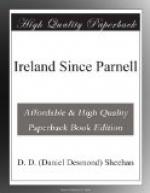Separation as the only road to independence was the burden of Pearse’s teaching. It was his definite purpose to do something which, by the splendour of the sacrifice involved, would rouse Ireland out of its national apathy and national stupor. He and his associates believed, as a writer in Nationality declared: “We have the material, the men and stuff of war, the faith and purpose and cause for revolution.... We shall have Ireland illumined with a light before which even the Martyrs’ will pale: the light of Freedom, of a deed done and action taken and a blow struck for the Old Land.” It was in this faith they went forth to their sacrifice. “On Palm Sunday 1916,” writes Mr Henry, “the Union of Irish Labour and Irish Nationality was proclaimed in a striking fashion. In the evening of that day Connolly hoisted over Liberty Hall, the headquarters of the Citizen Army, the Irish tricolour of orange, white, and green, the flag designed by the Young Irelanders in 1848 to symbolise the union of the Orange and Green by the white bond of a common brotherhood. On Easter Monday the Irish Republic was proclaimed in Arms in Dublin.”
Now there are many considerations that could be usefully discussed in relation to the Easter Week Rebellion, but this is not the time or place for them. Let it be made clear, however, that the Rising was not the work of Sinn Fein, but of the leaders of the Irish Volunteers and the Citizen Army. It would be a pretty subject of inquiry to know how Sinn Fein got the credit for the Rising and why the title was given to the new movement that came into being afterwards. My own view is that the British journalists who swarmed into Ireland are chiefly responsible for the designation. Sinn Fein was a fine mouthful for their British readers to swallow, and so they gave it to them. Be this as it may, the Rebellion came to be referred to as the Sinn Fein Rebellion, and the movement to which it gave birth has ever since assumed the same name. It is not my intention to dwell on the grave incidents that followed, the prolonged agony of “the shootings of the Rebel leaders,” the assassination of Mr Sheehy-Skeffington, the indecent scenes in the House of Commons when the Nationalist members behaved themselves with sad lack of restraint—cheering Mr Birrell’s prediction that “the Irish people would never regard the Dublin Rebellion with the same feelings with which they regarded previous rebellions,” cheering still more loudly when, in response to Sir Edward Carson’s invitation to Mr Redmond to join him in “denouncing and putting down those Rebels for evermore,” Mr Redmond expressed, to the amazement of all Nationalist Ireland, his “horror and detestation” of Irishmen who, however mistaken they may be—and history has yet to decide this—at least “poured out their blood like heroes—as they believed and as millions of their countrymen now believe for Ireland” (Mr William O’Brien). Mr Dillon, needless to say, flung his leader overboard on this occasion without the slightest truth. He declared he had never stood on a recruiting platform (which was not true!) and that he never would do so, and accused the Government and the soldiers of washing out the life-work of the Nationalists in “a sea of blood.”




